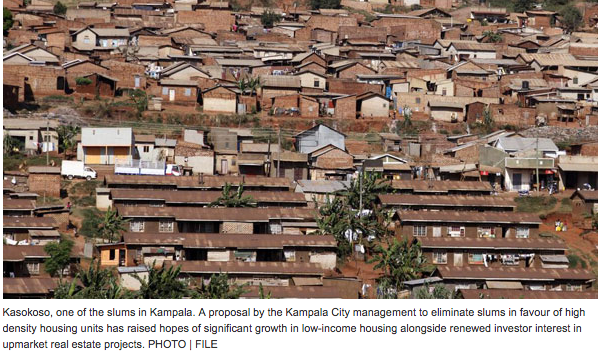According to Ministry of Lands, Housing and Urban Development (2015), 49% to 64% of the total urban population lives in slums.
Although the urbanization level is still low, the 5.1% urban population growth rate is very high and has far-reaching implications on development prospects of Uganda. This trend has continued to place serious demands on land, infrastructure, services and housing requirements.
With this trend of urbanization rate, Uganda’s urban centers have increasingly suffered from overcrowding or congestion; slums and informal settlements; housing shortage; urban poverty; unemployment; inadequate urban infrastructural services including water and sanitation facilities. The fastest growing urban centers in Uganda is Kampala city.
The city is a home to about two million people, 60% of who live in unplanned and poorly constructed areas according to the Ministry of Lands Housing and Urban Development (2015). Of the 1.6 national housing backlogs, Kampala has 100,000 housing units deficit. For a family in Kampala, it is almost impossible to obtain a safe and permanent home. Most housing in Kampala is characterized by poor housing conditions. Eco homes seem to the solution to housing problems, key with eco homes is:
- That the structures are like earth ships , utilizing everyday waste items like aluminum cans and glass and plastic bottles
- Water harvesting
- Energy saving
- Energy generation
- Zero carbon
- Zero waste say recycled concrete / granite
- Food production
- Passive solar building with thermal mass
Eco design considers Low Impact Materials looking at:
- Toxicity of ‘waste’ materials e.g. Tyres / plastics – The use of recycled plastic components makes sense, but we must be careful about embodied toxicity and making the building materials of now the waste composites of the future.
- Embodied energy of recyclable materials e.g. aluminum cans / glass bottles – Such as Re‐use of Aggregate, Reused or recycled materials or components would take precedence over equivalent ‘virgin’ materials. In some cases some construction projects are commended for its use of recycled aggregate in its concrete.
- Impact of natural materials e.g. stone / timber – This entails use of local materials or sourcing of materials from areas that are particularly fragile in respect of their aesthetic community or ecology, should be avoided. Low impact materials are Materials with significant reserves remaining should be used in preference to those with smaller reserves! Materials with significant reserves remaining should be used in preference to those with smaller reserves. Some of the locally mined materials in Uganda are high impact as a result of the difficulty involved in its regeneration.
 Eco homes is a new area of work under environmental sustainability in the constructions sector, consulting firms in Uganda have taken to this area of work and see this as really promising. The companies maintain rigorous in house quality assurance system. The quality assurance plan starts with thinking through the aspects of sustainability to ensure success of projects.
Eco homes is a new area of work under environmental sustainability in the constructions sector, consulting firms in Uganda have taken to this area of work and see this as really promising. The companies maintain rigorous in house quality assurance system. The quality assurance plan starts with thinking through the aspects of sustainability to ensure success of projects.
Construction methods are also key in achieving an appropriate eco home: handling of onsite and offsite pre-fabrications, to fabricate on site or not to, to use of green facades or not, possibility of generation of run down sites, the need for sustainability plans. These remain fundamental in the delivery of a sustainable housing sector.
The writer, Rebecca Alowo a DEng student at Central University of Technology, Free State South Africa.











